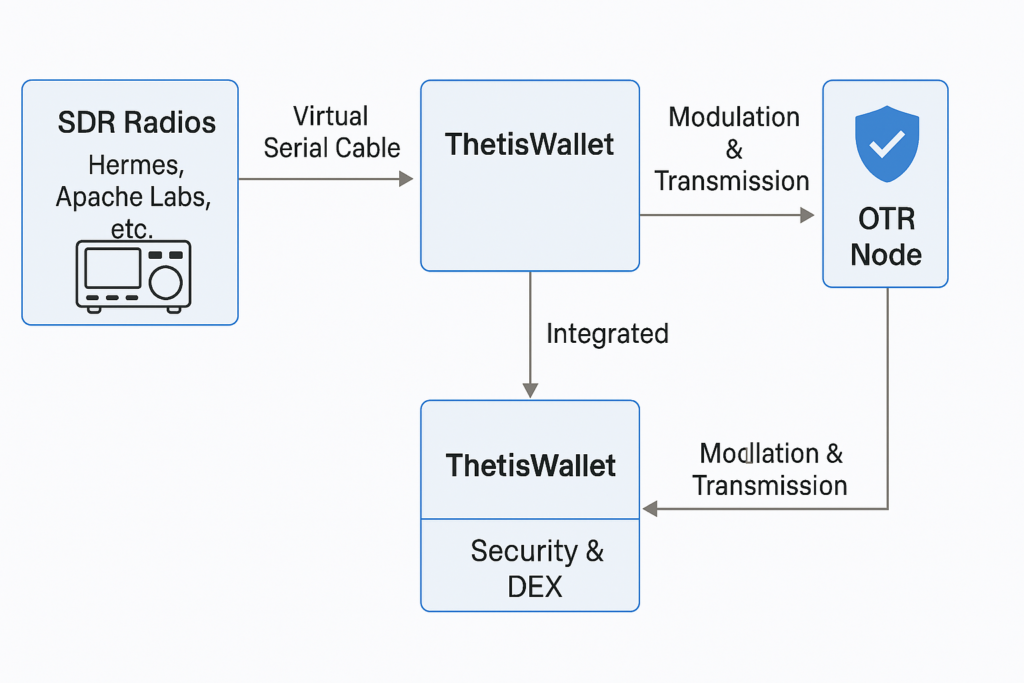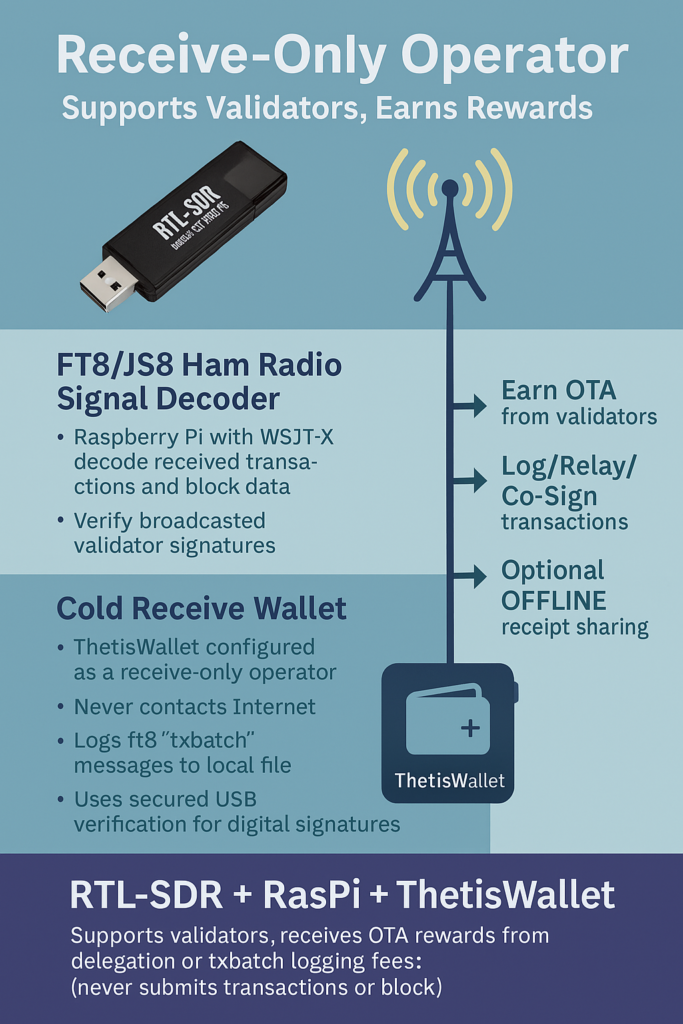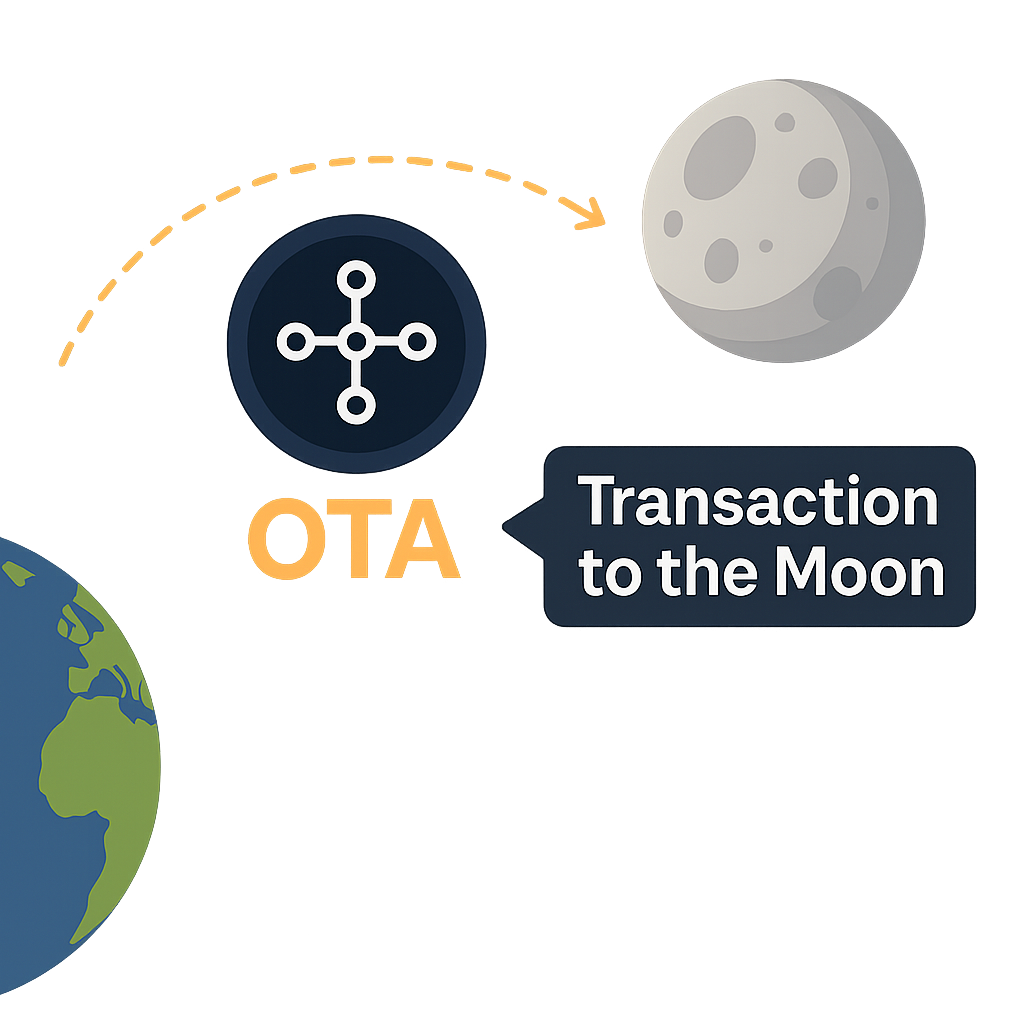
OTAwallet (Over The Air ) enables crypto wallet functionality in sdr software like Thetis and Sdr console. a connected radio and antenna. OTAwallet is poised to revolutionize crypto transaction capabilities by merging HF radio technology with Web3 innovations.
The OTAwallet is under development and to be released via GitHub when ready .
Built for use even when the internet goes down.Send, receive, and manage digital assets anywhere — with offline-ready features designed for real-world resiliency.
🔒 OTR( On The Radio) Blockchain vs Traditional Blockchains: Safety & Resilience Comparison
| Category | OTR (On The Radio) Chain | Traditional Blockchains (Ethereum, Bitcoin, etc.) |
|---|---|---|
| Connectivity | ✅ Can operate with no internet, using HF/VHF/UHF radio | ❌ Requires stable internet connection for all operations |
| Transaction Broadcast | ✅ Uses FT8, WSJT-X, or SDR relays or TCPIP | ❌ Needs TCP/IP to reach peers |
| Update Delivery | ✅ OTA patches via radio or USB (offline) | ❌ Updates require live node sync |
| Cold Wallet Support | ✅ Native USB export, air-gapped TX relay | ⚠️ Supported but not radio-friendly |
| Validator Sync | ✅ Broadcast over radio or receive-only snapshot | ❌ Sync only over internet |
| Tamper-Resilience | ✅ Uses IPFS + hash-linked SDR logs for audit | ⚠️ Can be tampered with unless logs stored externally |
| Operational Offline | ✅ Fully functional in offline / off-grid mode | ❌ Useless when disconnected |
| Power Resilience | ✅ Can run from battery, generator, solar setups | ❌ Needs constant power and connectivity |
| Security Surface | ✅ Smaller, focused stack; region-locked; call sign–tied | ❌ Public-by-default network, large attack surface |
| Access Control | ✅ Region/call sign-restricted chain access | ❌ Open globally — including adversarial access |
| Node Discovery | ✅ Radio broadcast-based peer introduction | ❌ Uses public IP gossip; traceable |
A little more of what is behind the scenes to make this work.
Create , encode, send, receive, decode, and ultimately (optionally) broadcast a Bitcoin transaction using the bit library and a simple UDP interface for JS8Call. In a real-world deployment, the sending and receiving functions would run on separate systems (or modules) and the radio side would interface with JS8Call or a similar HF digital mode tool.
Why OTR Is Infrastructure-Critical
- Resilience in Adversity
When the internet is down — due to disaster, war, or cyberattack — OTR nodes keep broadcasting via HF, VHF, UHF, and even satellite. Transactions still relay. Updates still apply. Wallets still verify. - Built for Sovereignty
OTR is region-restricted. Validators can enforce geo-fencing. This makes it safe to use for U.S. military, emergency services, and energy infrastructure without foreign interference. - True Offline Capability
Unlike other “cold wallet” chains that need internet to broadcast, OTR lets you:
Generate keys offline
Sign tx offline
Relay tx over radio to a node that will confirm it later
- AI + SDR Integration
The chain doesn’t just secure ‘data’ — it listens to signals. The AI assistant interprets FT8/call sign messages, schedules tx relays, and protects privacy even without live internet.
🧠 TL;DR
OTR isn’t just a blockchain. It’s a broadcast-grade financial infrastructure layer.
Where others fail under blackout, OTR transmits.
Where others are open to hostile actors, OTR is sovereign and secure.
We’re not just building safety — We’re engineering operational continuity for the age of digital warfare and off-grid resilience. 🧠📡🇺🇸

How It Works – OTA wallet ( codenamed Thetis)
1. Transaction Creation:
The function create_btc_transaction uses the bit library to construct and sign a transaction with a specified private key, recipient, and amount.
2. Encoding:
The raw transaction string is encoded to Base64 and split into manageable chunks (70 characters each) suitable for text transmission over HF modes such as JS8Call.
3. Sending via HF:
The send_js8call_message function sends each chunk over a UDP socket to the JS8Call API running on localhost (typically on port 2442). In a live setup, these messages would travel over HF.
4. Receiving and Decoding:
On the receiving end, chunks are reassembled and decoded back into the original transaction string using the decode_transaction function.
5. Broadcasting:
Finally, the decoded transaction can be broadcast to the Bitcoin network via the broadcast_transaction function (after proper testing and safety checks).

Another important feature in the lab is ‘Crossband repeating in crypto transmissions’ could be a game-changer, especially for secure, resilient, and long-range blockchain communication. This feature could allow OTAwallet to support transactions across multiple transmission bands (e.g., HF, VHF, UHF) for redundancy and reliability.
Potential Benefits of Crossband Repeating in Crypto Transactions
1. Resilient Transactions in Low-Connectivity Environments
• Crypto users in remote or off-grid locations (e.g., rural areas, disaster zones) could still process transactions via alternative transmission bands.
2. Decentralized & Censorship-Resistant Transactions
• By using crossband technology, transactions could hop between different frequencies, reducing reliance on centralized internet infrastructure.
3. Enhanced Security Against Interception
• Combining encryption with frequency shifting could prevent man-in-the-middle attacks, making it harder for adversaries to intercept or jam blockchain-based transactions.
4. Military & Commercial Use Cases
• Ideal for secure government communications, emergency response teams, and even private enterprises needing highly secure asset transfers over blockchain.
5. Integration With Ham Radio & IPFS
• Could allow blockchain transactions to be transmitted over radio frequencies, stored in IPFS, and later relayed to the blockchain once internet access is available..
Another feature that is in the works is
Cold Storage Key Management Flow

1. Key Generation:
• OTAwallet generates wallet keys and related files.
• Users are prompted to insert a USB device.
2. USB Write Process:
• OTAwallet securely writes the keys and files to the USB.
• A checksum or hash is created for each file during this process.
3. Verification Process:
• Upon plugging in the USB, OTAwallet verifies:
• File integrity (via checksum/hash comparison).
• File structure (ensuring no unexpected/malicious files are present).
• Key format correctness.
4. Confirmation:
• If verification succeeds, OTAwallet proceeds with transactions.
• If verification fails, the user is alerted to potential tampering.
5. Optional Security Enhancements:
• Encrypt the USB-stored keys with a user-defined passphrase.
• Encourage users to keep a second USB backup in a secure location.


In partnership with Stripe , OTAwallet can offer onboarding/offboarding options for users when internet is available.


Consider donating crypto to our development efforts below. Check out the whitepaper in the top right corner.
Those who donate , will be included beta testing and other perks .
Choose the amount you wish to donate.
Sign up for updates.
The use case described above is one of our inhouse web3 solutions powered by our SafeSignal™ api into a custom web3 wallet supporting a HF usecase.
In a pro-Web3 landscape, having the option to transact over a myriad of communication protocols is essential , using our API SafeSignal™l becomes the invisible backbone for:
Compliance-safe integration for wallets, dApps, and off-grid tools. Contacts us @ help [@] OTAwallet.com
Decentralized comms
Plug-and-play Web3 modules
SafeSignal™ is a drop-in data comms engine for every serious Web3 builder
